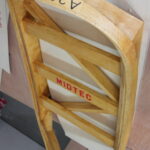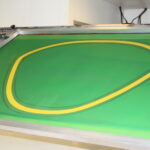
Have you ever wondered how your kitcar’s windscreen is produced? For many years the brilliant Peter Swan ran Pilkington’s Classic division on the Isle of Sheppey although soon after Peter retired Pilkington closed the facility.


Their mainstream windscreen factory is in Redditch and the production of specialist glass has moved to a corner of that factory too, although regardless of where it is made the manufacturing process is absolutely fascinating.
Over the years Pilkington has built a ‘library’ of handmade wooden formers covering most of the most popular kitcars dating back over fifty years. They store the ‘bucks’ in floor-to-ceiling metal stillages. If they get an order for say a Piper GTT ‘screen they go to their equivalent of a filing cabinet and retrieve the former.
I recall Peter telling me once that there are some that have only been used once but they were happy with that. After all, a car is rendered useless without a windscreen.
They have something like 3000 wooden moulds. Many of these would have come via Triplex moulds which Pilkington acquired in 1991. They also own the old SIGLA brand, too.
You name the car they have the means to produce a windscreen for it. If they don’t have one they will be able to produce one for you but be prepared to pay handsomely (anything from £3000 to £6000 to produce the required tooling), although you can rest assured that once they have the former it’s just a matter of making copies every time they get a call for the ‘screen.


This is why many manufacturers tend to use a proprietary windscreen from a mainstream car for their new project. It may sometimes compromise the shape they want to achieve but it will save them a shed load of cash. It’s worth remembering though that if you pay for the tooling you own the tooling and if Joe Bloggs wants one of your ‘screens’ you will have to give permission.
This is why owners’ clubs often place an order so that they have control of the windscreen supply for their members’ cars. That’s quite a popular way of doing things, Peter once told me.
Once ready to proceed, the technician cuts the appropriate shape using a template and reassuringly they still do this by hand just as it’s always been.
Once cut to shape the sharp edges are removed from the sheets of glass again by hand
The prepared glass sheet is then loaded into a massive ‘bending’ oven. As the name implies it is heated until it bends to shape over the forming tool, allowed to cool down naturally.



Once out of the oven shape and curvature is thoroughly checked against the mould. This is essential.
The bent pairs of glass are split apart (this is the dangerous stage as the glass wants to crack at this point) and a PVB sheet (basically a polyvinyl plastic or butyral sheet that has a plasticiser in it) is inserted between the two sheets of glass.
It is trimmed and a vacuum ring is applied around the glass edges. This is used to extract any air from the void. It is officially known as the ‘de-air’ stage. You now have a laminated windscreen.
If the customer wishes at the PVB stage they can add heated elements or an aerial or even a coloured tint.
Incidentally, the windscreen fitted to your Peugeot 2008 or Ford Focus or even Vauxhall Insignia is produced differently, as volume demands that the production process has to be faster. The glass is ‘flowed’ into shape. This involves molten glass being poured into a mould. The volumes involved here are massive.



The cost of a specialist windscreen these days probably starts at around £360 inc VAT or if you have a tint inserted then that cost would rise to about £450 inc VAT.
It really is great to watch a ‘screen being made and it’s comforting to know that Pilkington Classics still uses the skills they always have to produce the products although modern-day requirements mean that they have to add legal lettering and ‘e’ marks to the glass but other than that, your Gilbern Genie windscreen looks identical to how it did in 1975. More from www.pilkington.com.









